INSTITUT SUPERIEUR D'ANTHROPOLOGIE
INSTITUTE OF ANTHROPOLOGY
ONLINE COURSES / COURS A DISTANCE
FALL TERM : OCTOBER 2015
REGISTER NOW
VIET NAM – 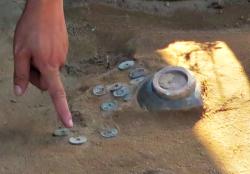 Khue Bac - An archeological team from Viet Nam Archaeology Institute found five stone axes believed to come from the 3,000-year-old Sa Huynh Culture at a Khue Bac communal house garden in the central city. The communal house lies at the foot of the Ngu Hanh Son Mountains (Marble Mountains), 15km from the city centre. Ho Tan Tuan, director of the city's Heritage Management Centre, said yesterday that the team unearthed the axes on Wednesday while digging a second pit in the garden. "The excavation, which began on May 16, provides more details on the appearance of the Sa Huynh Culture and the early Cham in the area," Tuan said. "The team is digging a larger pit in the hopes of finding more items in this second excavation of the garden." Tuan said archaeologists found hundreds of coins, ceramic pieces and stone fragments at the first 100sq.m pit, dug in 2001. Archaeologist Pham Van Trieu said the stone axes, ceramics and stones would have come from the Early Cham in the second and third centuries. "Items found from in the two excavations prove two cultures – the Early Cham and the Sa Huynh – existed in the garden of the Khue Bac communal house," Trieu said. "The discovery also revealed that the upper layer was the Early Cham and the second was the Sa Huynh." Trieu said figures on the coins also proved that Chinese traders did business in the region in the 17th and 18th centuries. The excavation also proved the existence of people before the Sa Huynh, and the connection between the Sa Huynh and Cham. The archaeological team will continue to search the garden, and announce their final results early next month. Between 2012 and 2014, archaeologists from Ha Noi's University of Social Sciences and Humanities and Da Nang's Cham Sculpture Museum found foundations of Cham tower complexes in Qua Giang and Phong Le Village in Hoa Vang District. The towers were built to honour the Champa King, who ruled the region between the fourth and 13th centuries.
Khue Bac - An archeological team from Viet Nam Archaeology Institute found five stone axes believed to come from the 3,000-year-old Sa Huynh Culture at a Khue Bac communal house garden in the central city. The communal house lies at the foot of the Ngu Hanh Son Mountains (Marble Mountains), 15km from the city centre. Ho Tan Tuan, director of the city's Heritage Management Centre, said yesterday that the team unearthed the axes on Wednesday while digging a second pit in the garden. "The excavation, which began on May 16, provides more details on the appearance of the Sa Huynh Culture and the early Cham in the area," Tuan said. "The team is digging a larger pit in the hopes of finding more items in this second excavation of the garden." Tuan said archaeologists found hundreds of coins, ceramic pieces and stone fragments at the first 100sq.m pit, dug in 2001. Archaeologist Pham Van Trieu said the stone axes, ceramics and stones would have come from the Early Cham in the second and third centuries. "Items found from in the two excavations prove two cultures – the Early Cham and the Sa Huynh – existed in the garden of the Khue Bac communal house," Trieu said. "The discovery also revealed that the upper layer was the Early Cham and the second was the Sa Huynh." Trieu said figures on the coins also proved that Chinese traders did business in the region in the 17th and 18th centuries. The excavation also proved the existence of people before the Sa Huynh, and the connection between the Sa Huynh and Cham. The archaeological team will continue to search the garden, and announce their final results early next month. Between 2012 and 2014, archaeologists from Ha Noi's University of Social Sciences and Humanities and Da Nang's Cham Sculpture Museum found foundations of Cham tower complexes in Qua Giang and Phong Le Village in Hoa Vang District. The towers were built to honour the Champa King, who ruled the region between the fourth and 13th centuries.
http://english.vietnamnet.vn/fms/art-entertainment/132165/valuable-items-of-sa-huynh-culture-found-in-da-nang.html
USA - Mashantucket - Archaeological work on the Mashantucket Pequot reservation has uncovered a 12,000-year-old site once occupied by Paleoindians, among New England's earliest occupants, according to a press release from the Mashantucket Pequot Tribe. The site was discovered during an archaeological survey and uncovered artifacts representing a range of different tools — most notably spear tips made in the distinctive Paleoindian "fluted point" style. Other artifacts represent a variety of activities associated with hunting and gathering such as tool-making and repair, butchering, hide-scraping and tanning, and clothes making, according to the release, which explained occupants of this site would have relied on caribou, waterfowl, and nearby wetland plants. Nearly all of the artifacts were made from stone originating in Pennsylvania, New York, and Maine, a sign that the group traveled widely.
http://www.theday.com/local/20150601/-archaeologists-discover-12000-year-old-site-at-mashantucket--
AFRIQUE DU SUD – 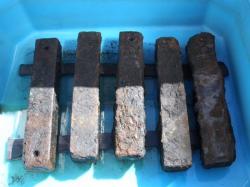 Cape Town - For some time, researchers suspected that the São José-Paquete de Africa, a Portuguese slave ship, had crashed in 1794 off the coast of Cape Town, South Africa. But only now, after years of painstaking work, have they finally confirmed it. In the 1980s, treasure hunters mistakenly identified the São José as an earlier Dutch vessel, according to the Smithsonian. But in 2011, researchers found the São José captain's account, which sparked new interest in the ship. Since then, the discovery of artifacts, including the remains of shackles and iron ballast, which was often used to stabilize slave ships, lent credence to the theory that the wreck near Cape Town was in fact the São José. The Smithsonian says the ship was carrying more than 400 slaves from Mozambique to Brazil when it struck a rock and began to sink. More than 200 of those slaves died; the rest were likely sold back into slavery just days after being rescued from the sinking ship.
Cape Town - For some time, researchers suspected that the São José-Paquete de Africa, a Portuguese slave ship, had crashed in 1794 off the coast of Cape Town, South Africa. But only now, after years of painstaking work, have they finally confirmed it. In the 1980s, treasure hunters mistakenly identified the São José as an earlier Dutch vessel, according to the Smithsonian. But in 2011, researchers found the São José captain's account, which sparked new interest in the ship. Since then, the discovery of artifacts, including the remains of shackles and iron ballast, which was often used to stabilize slave ships, lent credence to the theory that the wreck near Cape Town was in fact the São José. The Smithsonian says the ship was carrying more than 400 slaves from Mozambique to Brazil when it struck a rock and began to sink. More than 200 of those slaves died; the rest were likely sold back into slavery just days after being rescued from the sinking ship.
http://whqr.org/post/wreck-221-year-old-slave-ship-confirmed-south-africa
ROYAUME UNI – 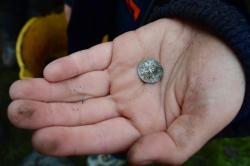 Wark Castle - A coin dating back to the reign of Edward I has been found by young archaeologists at a Northumberland castle. The hammer silver coin, identified as an Edward I cross halfpenny, was unearthed during a dig at the remains of Wark Castle by the Flodden Young Archaeologists’ Club working with the Flodden 1513 archaeology team. Edward I was known as Longshanks because of his height, and also as the Hammer of the Scots because of his involvement in the Scottish succession when he decided the competing claims of John Balliol and Robert Bruce to the Scottish Crown. He was the first king to mint half pennys, starting shortly after he came to the English throne in 1272. During the medieval period Wark was one of the most strategically important castles in the country, due to its location on the border, and was the scene of frequent skirmishes and sieges. In 1513 it was one of the first castles captured by James IV’s Scottish army before the Battle of Flodden. After Flodden, the castle must have been quickly repaired by the English as a 1517 account showed it to be fully equipped and operational again.
Wark Castle - A coin dating back to the reign of Edward I has been found by young archaeologists at a Northumberland castle. The hammer silver coin, identified as an Edward I cross halfpenny, was unearthed during a dig at the remains of Wark Castle by the Flodden Young Archaeologists’ Club working with the Flodden 1513 archaeology team. Edward I was known as Longshanks because of his height, and also as the Hammer of the Scots because of his involvement in the Scottish succession when he decided the competing claims of John Balliol and Robert Bruce to the Scottish Crown. He was the first king to mint half pennys, starting shortly after he came to the English throne in 1272. During the medieval period Wark was one of the most strategically important castles in the country, due to its location on the border, and was the scene of frequent skirmishes and sieges. In 1513 it was one of the first castles captured by James IV’s Scottish army before the Battle of Flodden. After Flodden, the castle must have been quickly repaired by the English as a 1517 account showed it to be fully equipped and operational again.
http://www.chroniclelive.co.uk/news/north-east-news/young-archaeologists-uncover-coin-era-9366729
FRANCE – 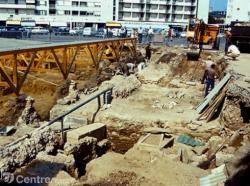 Limoges - Des fouilles programmées vont débuter place de la République et rue Saint-Martial. La nouvelle campagne de fouilles archéologiques menée par la société Éveha doit permettre d'approfondir la connaissance de ce site historique. Le tout, dans la continuité des sondages déjà réalisés dans les années 60, puis entre 2006 et jusqu'à l'an dernier. Ces fouilles s'effectueront en deux phases : de début juin à novembre ; puis entre mars et juin 2016. Dès 1958, des passionnés d'archéologieproposent à la ville de retrouver la tombe de saint Martial. « Nous avions quelques indications, se souvient Jean-Pierre Loustaud. En trouvant la crypte, cela nous a permis de mettre en lumière sa complexité. » Une grosse surprise les attend : « Nous découvrons une fissuration dans le sol. Et, en creusant, nous tombons sur une fosse avec deux sarcophages : un plus long, celui de saint Martial et un plus large, celui de ses deux compagnons, mais sans les reliques. » Dès lors, la ville décide de protéger l'ensemble par une crypte archéologique ouverte au public en 1962. Entre 1965 et 1966 « nous découvrons les deux églises Saint-Pierre du Sépulcre et Saint-Benoît, ainsi que des dizaines de tombes, nécropole du Bas-Empire et au-delà. » La construction du parking sous la place complique la tâche des archéologues. « Nous évoluons alors au milieu des pelleteuses, avec des terrassiers, dans la boue. Des vestiges sont détruits sous nos yeux… Nous découvrons des traces d'occupation de la ville antique, une maison, des systèmes de chauffage, des murs de facture romaine, des réemplois sur plusieurs couches et plusieurs époques. On trouve aussi une petite chapelle inconnue, hors de la crypte, des éléments de remparts. »
Limoges - Des fouilles programmées vont débuter place de la République et rue Saint-Martial. La nouvelle campagne de fouilles archéologiques menée par la société Éveha doit permettre d'approfondir la connaissance de ce site historique. Le tout, dans la continuité des sondages déjà réalisés dans les années 60, puis entre 2006 et jusqu'à l'an dernier. Ces fouilles s'effectueront en deux phases : de début juin à novembre ; puis entre mars et juin 2016. Dès 1958, des passionnés d'archéologieproposent à la ville de retrouver la tombe de saint Martial. « Nous avions quelques indications, se souvient Jean-Pierre Loustaud. En trouvant la crypte, cela nous a permis de mettre en lumière sa complexité. » Une grosse surprise les attend : « Nous découvrons une fissuration dans le sol. Et, en creusant, nous tombons sur une fosse avec deux sarcophages : un plus long, celui de saint Martial et un plus large, celui de ses deux compagnons, mais sans les reliques. » Dès lors, la ville décide de protéger l'ensemble par une crypte archéologique ouverte au public en 1962. Entre 1965 et 1966 « nous découvrons les deux églises Saint-Pierre du Sépulcre et Saint-Benoît, ainsi que des dizaines de tombes, nécropole du Bas-Empire et au-delà. » La construction du parking sous la place complique la tâche des archéologues. « Nous évoluons alors au milieu des pelleteuses, avec des terrassiers, dans la boue. Des vestiges sont détruits sous nos yeux… Nous découvrons des traces d'occupation de la ville antique, une maison, des systèmes de chauffage, des murs de facture romaine, des réemplois sur plusieurs couches et plusieurs époques. On trouve aussi une petite chapelle inconnue, hors de la crypte, des éléments de remparts. »
http://www.lepopulaire.fr/limousin/actualite/departement/haute-vienne/2015/05/26/il-y-a-plus-dun-demi-siecle-des-fouilles-archeologiques-etaient-lancees-place-de-la-republique_11453677.html
TUNISIE - Remada - Un site archéologique datant de 8000 avant Jésus-Christ (J.C) a été découvert dans le sud de la Tunisie, c’est ce qu’a annoncé le chercheur en archéologie, Ali Bousnina, mercredi 27 mai 2015? dans une déclaration à la radio nationale. Le site en question est situé à 5 kilomètres de la ville de Kambout, à Remada, du gouvernorat de Tataouine.
http://directinfo.webmanagercenter.com/2015/05/29/decouverte-dun-site-archeologique-vieux-de-8000-avant-jesus-christ-en-tunisie/
COREES – Kaesong - South and North Korea embarked on a six-month joint excavation project at the site of an ancient palace on Monday, a rare example of cooperation at a time of strained ties. South Korea’s Unification Ministry, which is in charge of inter-Korean relations, said Sunday an inter-Korean association of historians would start joint excavation work of a palace called Manwoldae, which was built during the Goryeo Dynasty (918-1392) near the border city of Kaesong, home to the Kaesong Joint Industrial Complex, the last remaining symbol of inter-Korean business cooperation. Around 50 percent of the total area, which covers 33,000 square meters (355,209 square feet), will be excavated by the end of the project on Nov. 30.
http://koreajoongangdaily.joins.com/news/article/Article.aspx?aid=3004856
ROYAUME UNI –  Selby - A two thousand-year-old figurine of the Roman god Mercury has become the 1,000th archeological object this year to be officially recorded in North and East Yorkshire as part of a government-funded project. The worn copper alloy figurine of the Roman god of commerce and travellers was found by Dave Cooper, member of the York and District Metal Detecting Club, in a field near Selby. Mercury was one of the more popular Roman gods, with similar examples already found across the country giving an insight into the religious practices of Roman Britain.
Selby - A two thousand-year-old figurine of the Roman god Mercury has become the 1,000th archeological object this year to be officially recorded in North and East Yorkshire as part of a government-funded project. The worn copper alloy figurine of the Roman god of commerce and travellers was found by Dave Cooper, member of the York and District Metal Detecting Club, in a field near Selby. Mercury was one of the more popular Roman gods, with similar examples already found across the country giving an insight into the religious practices of Roman Britain.
http://www.yorkshirepost.co.uk/news/main-topics/general-news/archeology-milestone-as-mercury-figurine-is-discovered-near-selby-1-7288285
BULGARIE – 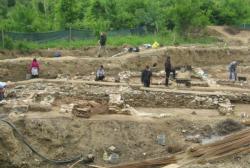 Sapareva Banya - Construction workers have come across the remains of an Ancient Roman building from the Late Antiquity on a private property in the southwestern Bulgarian town of Sapareva Banya. The newly discovered Late Antiquity Roman building has a large area but its precise function is still unclear, explains lead archaeologist Rumen Spasov. “A matter of interest is a room where the floor is covered with collapsed roof tiles, which have not been produced in the past 1,600 years. These tiles are 70 cm long, 40 cm wide, and 3 cm thick. Such heavy tiles require a robust roof structure,” Spasov is quoted as saying. The newly discovered Roman Age building has yielded a number of artifacts, including bronze coins, an iron pickaxe, and several pottery vessels. He adds that the building itself was destroyed in the first half of the 5th century AD, at about the same time as a Roman villa discovered in the nearby town of Dyakovo in 2012, whose excavation was completed in 2013. The mentioned Roman villa in Dyakovo was discovered during rescue excavations along the route of the Struma Highway, which will connect Bulgaria’s capital Sofia with Greece. In the spring of 2014, another Late Antiquity discovery was made by accident by construction workersworking on a private property in Bulgaria’s Sapareva Banya: an Ancient Roman tomb containing the remains of a man, a woman, and a child.
Sapareva Banya - Construction workers have come across the remains of an Ancient Roman building from the Late Antiquity on a private property in the southwestern Bulgarian town of Sapareva Banya. The newly discovered Late Antiquity Roman building has a large area but its precise function is still unclear, explains lead archaeologist Rumen Spasov. “A matter of interest is a room where the floor is covered with collapsed roof tiles, which have not been produced in the past 1,600 years. These tiles are 70 cm long, 40 cm wide, and 3 cm thick. Such heavy tiles require a robust roof structure,” Spasov is quoted as saying. The newly discovered Roman Age building has yielded a number of artifacts, including bronze coins, an iron pickaxe, and several pottery vessels. He adds that the building itself was destroyed in the first half of the 5th century AD, at about the same time as a Roman villa discovered in the nearby town of Dyakovo in 2012, whose excavation was completed in 2013. The mentioned Roman villa in Dyakovo was discovered during rescue excavations along the route of the Struma Highway, which will connect Bulgaria’s capital Sofia with Greece. In the spring of 2014, another Late Antiquity discovery was made by accident by construction workersworking on a private property in Bulgaria’s Sapareva Banya: an Ancient Roman tomb containing the remains of a man, a woman, and a child.
http://archaeologyinbulgaria.com/2015/06/01/construction-workers-stumble-upon-late-antiquity-roman-building-in-bulgarias-sapareva-banya/